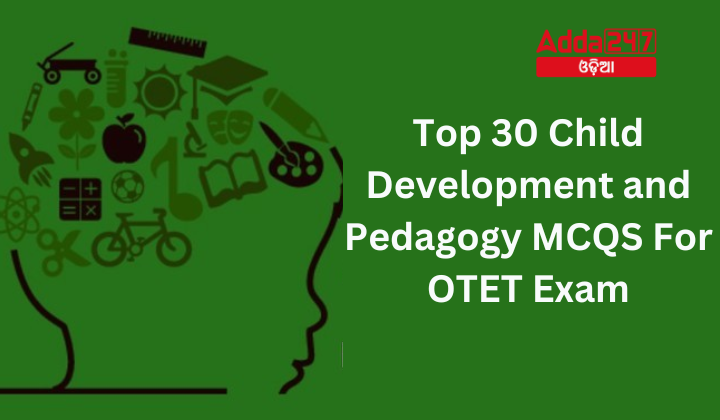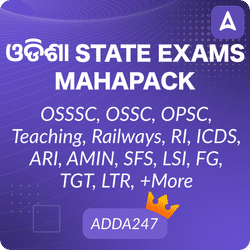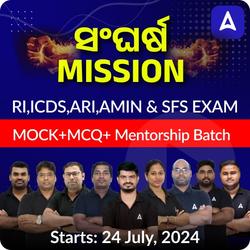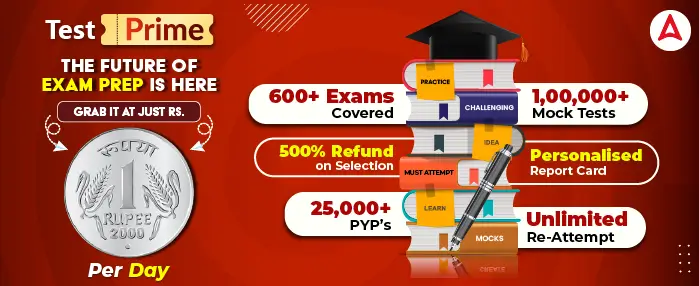The Odisha Teacher Eligibility Test (OTET) assesses the eligibility of candidates to teach in schools of Odisha. A crucial section of this exam is Child Development and Pedagogy, which evaluates understanding of child development and the principles of pedagogy. Below are 30 multiple-choice questions (MCQs) designed to help candidates prepare for this section.
Top 30 Child Development and Pedagogy MCQS For OTET Exam
- Which of the following stages of child development is characterized by rapid physical growth?
(a) Infancy
(b) Early Childhood
(c) Middle Childhood
(d) Adolescence
Ans. (a) Infancy - What principle of child development suggests that development proceeds from the head downward?
(a) Proximodistal
(b) Cephalocaudal
(c) Hierarchical integration
(d) Independence of systems
Ans. (b) Cephalocaudal - At what stage do children typically develop a sense of morality and ethics?
(a) Infancy
(b) Early Childhood
(c) Middle Childhood
(d) Adolescence
Ans. (c) Middle Childhood - How does heredity influence child development?
(a) It determines all aspects of development
(b) It has no influence
(c) It provides the potential for development
(d) It shapes environmental interactions
Ans. (c) It provides the potential for development - Which aspect of child development is influenced by both heredity and environment?
(a) Physical
(b) Cognitive
(c) Social
(d) All of the above
Ans. (d) All of the above - What is the nature of learning according to constructivist theory?
(a) Passive absorption of information
(b) Active construction of knowledge
(c) Memorization of facts
(d) Imitation of others
Ans. (b) Active construction of knowledge - How does individual difference affect learning in a classroom?
(a) It has no effect
(b) It determines the methods used by the teacher
(c) It requires personalized teaching strategies
(d) It complicates the teaching process
Ans. (c) It requires personalized teaching strategies - Which method of learning emphasizes observation and imitation?
(a) Classical conditioning
(b) Operant conditioning
(c) Social learning
(d) Insight learning
Ans. (c) Social learning - What basic condition is essential for effective learning in a classroom?
(a) Strict discipline
(b) High competition
(c) Positive learning environment
(d) Heavy homework load
Ans. (c) Positive learning environment - What role does motivation play in the learning process?
(a) It hinders learning
(b) It has no effect
(c) It enhances learning
(d) It replaces the need for good teaching
Ans. (c) It enhances learning - What is a key characteristic of creative thinking?
(a) Conformity
(b) Originality
(c) Repetition
(d) Predictability
Ans. (b) Originality - How can teachers foster creativity in students?
(a) By providing strict guidelines
(b) By allowing free exploration
(c) By emphasizing memorization
(d) By discouraging unconventional ideas
Ans. (b) By allowing free exploration - Which of the following is an example of a creative thinking activity?
(a) Multiple-choice quiz
(b) Rote learning
(c) Brainstorming session
(d) Copying notes
Ans. (c) Brainstorming session - What is the goal of inclusive education?
(a) Segregating special needs students
(b) Integrating all students into mainstream classrooms
(c) Providing separate facilities for different groups
(d) Focusing only on academic achievements
Ans. (b) Integrating all students into mainstream classrooms - Which group is specifically addressed in inclusive education?
(a) Only students with disabilities
(b) All students, including those with disabilities, girls, and SC/ST students
(c) Only high achievers
(d) Only average students
Ans. (b) All students, including those with disabilities, girls, and SC/ST students - How can teachers address the needs of talented and creative learners?
(a) By giving them additional standard assignments
(b) By providing opportunities for advanced projects and challenges
(c) By having them assist with teaching
(d) By ignoring their special needs
Ans. (b) By providing opportunities for advanced projects and challenges - Which teaching approach focuses on student activity and participation?
(a) Teacher-centred
(b) Learner-centred
(c) Lecture-based
(d) Memorization
Ans. (b) Learner-centred - What is the main characteristic of a competency-based approach?
(a) Focus on theoretical knowledge
(b) Emphasis on skills and competencies
(c) Reliance on lectures
(d) Use of standardized tests
Ans. (b) Emphasis on skills and competencies - What is the purpose of using Teaching-Learning Materials (TLM)?
(a) To make the classroom more attractive
(b) To aid in the understanding and retention of concepts
(c) To save the teacher’s time
(d) To assess students
Ans. (b) To aid in the understanding and retention of concepts - What is a mono-grade classroom?
(a) A classroom with students of different age groups
(b) A classroom with students of the same age group and grade level
(c) A classroom with mixed academic levels
(d) A classroom with only special needs students
Ans. (b) A classroom with students of the same age group and grade level - How can a teacher effectively manage a multi-grade classroom?
(a) By focusing on one grade at a time
(b) By providing differentiated instruction tailored to each grade level
(c) By ignoring grade differences
(d) By using a one-size-fits-all approach
Ans. (b) By providing differentiated instruction tailored to each grade level - What is the primary purpose of assessment in education?
(a) To rank students
(b) To diagnose learning needs and progress
(c) To create competition
(d) To prepare report cards
Ans. (b) To diagnose learning needs and progress - Which type of assessment is ongoing and integral to the teaching-learning process?
(a) Summative
(b) Diagnostic
(c) Formative
(d) Predictive
Ans. (c) Formative - How can continuous and comprehensive assessment benefit students?
(a) By emphasizing rote learning
(b) By providing regular feedback and supporting holistic development
(c) By stressing standardized testing
(d) By reducing teacher workload
Ans. (b) By providing regular feedback and supporting holistic development - What does assessing scholastic and co-scholastic areas involve?
(a) Focusing only on academic subjects
(b) Evaluating both academic performance and extracurricular activities
(c) Ignoring non-academic skills
(d) Using only written exams
Ans. (b) Evaluating both academic performance and extracurricular activities - How should assessment outcomes be shared with students and parents?
(a) Secretly and selectively
(b) Transparently and constructively
(c) Rarely and reluctantly
(d) Only in report cards
Ans. (b) Transparently and constructively - In child development, what is a significant milestone during early childhood?
(a) Walking
(b) Abstract reasoning
(c) Formal operations
(d) Retirement planning
Ans. (a) Walking - Which theory emphasizes the social and cultural context of learning?
(a) Behaviorism
(b) Cognitive Development Theory
(c) Socio-cultural Theory
(d) Humanistic Theory
Ans. (c) Socio-cultural Theory - How can teachers support students with learning disabilities in an inclusive classroom?
(a) By lowering academic expectations
(b) By providing individualized support and accommodations
(c) By segregating them from their peers
(d) By giving them less homework
Ans. (b) By providing individualized support and accommodations - What is the primary benefit of a learner-centred approach?
(a) It simplifies lesson planning
(b) It engages students actively in their own learning process
(c) It reduces the need for assessments
(d) It focuses on the teacher’s expertise
Ans. (b) It engages students actively in their own learning process

